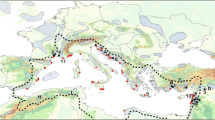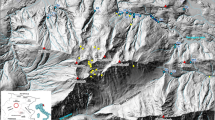Abstract
The hydrogeological study of some karst systems in Lebanon shows important storage capacity, up to 27 billions m3 for Zarka system, the spring of Orontes River. Their geological and morphological settings, as well as their hydrodynamic function, show structures developed below the level of present springs, probably up to several hundreds meters at depth. Since Miocene, those carbonate formations were subject to a remarkable instability of their base levels. Variations of sea level, of which the Messinian salinity crisis is the major phase, and effects of the alpine orogenesis, combined with climate variations to develop complex, multiphased karst systems. Karstification occurs frequently in the whole formation, often deeply below sea level or underneath sediment filling of continental basins. The surface karst landscape is often intensely eroded. Those multiple, superimposed karst phases give the carbonate aquifers their large extension and storage capacity. These karst aquifers show the typical easy restoration of storage. They have the ability to bear large interannual recharge variations and support exploitation under high pumping rates. However, these aquifers have some disadvantages for sustainable management. In some regions, successful boreholes, which allow high pumping rates also induce uncontrolled exploitation. Another consequence is natural seawater intrusion, as well as the submarine discharge of fresh groundwater, in coastal aquifers. Those carbonate aquifers are subject to important economical stress which jeopardizes their durability. The systematic study and understanding of carbonate aquifers in Eastern Mediterranean is a preliminary condition to any integrated and sustainable management of water resources. Studies in progress in Lebanon may serve as examples to the whole region.




Similar content being viewed by others
References
Abd-el-Al I (1967) Statique et dynamique des eaux dans les massifs calcaires libano-syriens. Chronique d’Hydrogéologie 10:75–92
Abdul-Nour H, Ghaouche A, Kallab O (1991) Essai de synthèse spéléologique des hauts-plateaux de Aaqoura–Roueiss. Liban Souterrain 3:73–82
Azar D (2000) Contribution à l’étude de la source karstique d’Afka (Liban). DEA Thesis, St Joseph Beyrouth, Beyrouth, 101 pp
Bakalowicz M (1970) Hydrodynamique karstique: étude du bassin d’alimentation de la Manavgat (Taurus occidental, Turquie). Doctorat de 3ème cycle Thesis, Université Paris 6, Thonon, 106 pp
Bakalowicz M (1973) Les grandes manifestations hydrogéologiques des karsts dans le monde. Spelunca Bull 2:38–40
Bakalowicz M (2005) Karst groundwater: a challenge for new resources. Hydrogeol J 13(1):148–160
Bakalowicz M, Olive P (1970a) Contribution à l’étude de l’hydrodynamique karstique par les techniques isotopiques. Spelunca Mémoires 7:61–65
Bakalowicz M, Olive P (1970b) Teneurs en tritium des eaux du karst du Taurus occidental et de Pisidie (Turquie). Schweiz Z Hydrologie 32(2):475–480
Boussinesq J (1904) Recherches théoriques sur l'écoulement des nappes d'eau infiltrées dans le sol et sur le débit des sources. Journal des Mathématiques pures et appliquées 10:5–78
Clauzon G (1982) Le canyon messinien du Rhône: une preuve décisive du “dessicated-deep model” (Hsü, Cita et Ryan, 1973). Bull Soc Géol France 24(7):597–610
Daëron M (2005) Rôle, cinématique et comportement sismique à long terme de la faille de Yammouneh, principale branche décrochante du coude transpressif libanais (faille du Levant). Thèse de Doctorat Thesis, Institut de Physique du Globe de Paris, Paris, 179 pp
Dewandel B, Lachassagne P, Bakalowicz M, Weng P, Al-Malki A (2003) Evaluation of aquifer thickness by analysing recession hydrographs. Application to the Oman ophiolite hard-rock aquifer. J Hydrol 274:248–269
El Hakim M (2005) Les aquifères karstiques de l’Anti-Liban et du nord de la plaine de la Bekaa: caractéristiques, fonctionnement, modélisation, gestion et protection. PhD Thesis, Université Montpellier 2, Montpellier, 213 pp
El Hakim M, Bakalowicz M (2007) Significance and origin of very large regulating power of some karst aquifers in the Middle East. Implication on karst aquifer classification. J Hydrol 333:329–339
Elias A (2006) Le Chevauchement de Tripoli-Saida: Croissance du Mont-Liban et risque sismique. PhD Thesis, Paris, 231 pp
Ford DC, Williams PW (1989) Karst geomorphology and hydrology. Academic Division of Unwin Hyman Ltd, London, 601 pp
Kareh R (1967) Les sources sous-marines de Chekka (Liban). Doctorat de 3ème cycle, Université de Montpellier, 51 pp. In: Hannon, Revue libanaise de géographie, 1967, II, pp 35–59; 1968, III, pp 94–121
Kattan Z (1994) Environmental isotope study of the major karst springs in Damascus limestone aquifer systems: case of the Figeh and Barada springs, Final co-ordination meeting of a regional technical co-operation project. IAEA, Ankara, pp 127–150
Kattan Z (1997) Environmental isotope study of the major karst springs in Damascus limestone aquifer systems: case of the Figeh and Barada springs. J Hydrol 193:161–182
Maalouf F (1999) Approche du fonctionnement de l’aquifère de l’Oronte. Mémoire DEA Thesis, Université St Joseph de Beyrouth, Beyrouth, 67 pp
Maillet E (1905) Essais d'hydraulique souterraine et fluviale. Hermann, Paris, 218 pp
Mangin A (1974a) Contribution à l’étude hydrodynamique des aquifères karstiques. 1ère partie. Généralités sur le karst et les lois d’écoulement utilisées. Ann Spéléol 29(3):283–332
Mangin A (1974b) Contribution à l’étude hydrodynamique des aquifères karstiques. 2ème partie. Concepts méthodologiques adoptés. Systèmes karstiques étudiés. Ann Spéléol 29(4):495–601
Mangin A (1975) Contribution à l’étude hydrodynamique des aquifères karstiques. 3ème partie. Constitution et fonctionnement des aquifères karstiques. Ann Spéléol 30(1):21–124
Marsaud B (1996) Structure et fonctionnement de la zone noyée des karsts à partir des résultats expérimentaux. Thèse de doctorat Thesis, Paris XI, Orsay, 305 pp
Milanovic P (2000) Geological engineering in karst. Zebra, Belgrade, 347 pp
PNUD (1970) Liban. Etude des eaux souterraines, Nations Unies, New York
Rouchy JM, Saint-Martin JP (1992) Late Miocene events in the Mediterranean as recorded by carbonate-evaporite relations. Geology 20:629–632
Shaban A, Khawlie M, Abdallah C, Faour G (2005) Geologic control of submarine groundwater discharge: application of remote sensing to north Lebanon. Environ Geol 47:512–522
Author information
Authors and Affiliations
Corresponding author
Rights and permissions
About this article
Cite this article
Bakalowicz, M., El Hakim, M. & El-Hajj, A. Karst groundwater resources in the countries of eastern Mediterranean: the example of Lebanon. Environ Geol 54, 597–604 (2008). https://doi.org/10.1007/s00254-007-0854-z
Received:
Accepted:
Published:
Issue Date:
DOI: https://doi.org/10.1007/s00254-007-0854-z




